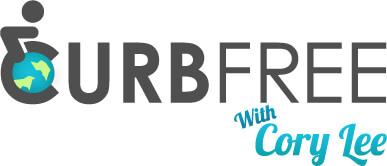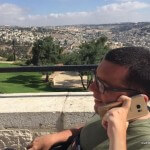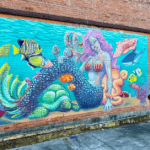.
*This is a guest post from Hannah Soyer*
SXSW (South by Southwest) is a huge creative festival that occurs every year in Austin, Texas, for about 10 days. Although it started as a music festival in the late 80’s, it has since grown into a conglomeration of film festival, comedy festival, music festival, and interactive festival (think panels, speakers, and workshops).
My SXSW adventure began sometime this past summer, when Mexican disability activist Maryangel Garcia-Ramos contacted me to see if I would be interested in being on a panel she was proposing about women with disabilities, beauty and sex. I had been working on an article for Cosmopolitan magazine on disability and sex and had interviewed Maryangel as one of my sources. I didn’t really know what SXSW was, or how I would get to Texas from my home in Iowa if our panel was selected, but I thought it sounded like a great opportunity, so I enthusiastically agreed.
Fast forward to early fall, when I opened up my email to see that our panel had been picked! Now came the planning and scouting out for accessible places to stay, accessible routes to take, essentially all of the added planning that goes into traveling when you have a disability.
I am happy to report, however, that my first time at SXSW was an incredible experience and (from my perspective, which I recognize could be different from others’) relatively disability friendly. There were some hiccups that I’ll address below, but ultimately SXSW is something I will be attending again, and something I would recommend to anyone.
Getting there
We decided to drive the approximately 14 hours from my home in Des Moines, IA, to Austin because doing so was ultimately quite a bit cheaper than flying. Flying with a disability and wheelchair can also be a huge hassle, as anyone who uses a chair and has flown can attest to. We broke the drive up into two days, which wasn’t horrible, but still not fun if you have limited mobility and get uncomfortable if you’re in one position for too long. If (when) I go back to SXSW, I’ll definitely fly. It was incredibly convenient, however, to have my accessible van with us in Austin (more on this later).

One of my favorite places in Austin was the Museum of the Weird, which essentially housed a bunch of weird sideshow-like things such as shrunken heads and animals with twice the number of legs as they should have. This is me with a “Fiji Mermaid,” a creature that was formed by fusing the head of a human or monkey with the body of a fish. This particular Fiji Mermaid supposedly traveled with P.T. Barnum of Barnum and Bailey’s Circus. The Museum of the Weird is partially accessible, but because wheelchairs cannot access the entire space, I paid for a discounted ticket at $8.
Personal care attendant accommodations
Because of the amount of help I require, I always take a minimum of two personal care attendants with me when traveling. This time, I took my mom and my best friend, Haley. SXSW has this amazing policy that if someone needs a companion with them at all times, this person can get a free companion wristband and accompany the person that needs assistance wherever they go.
Before we left for Austin, I got in touch with the Access department of SXSW to verify this, and to explain that I have two companions with me. The people I spoke to were very friendly and even told me that it would be no problem at all for me to get two companion wristbands for both of my helpers. This was such a relief and surprise for me, as much of my travels end up being more expensive, because I absolutely need people with me.
In fact, there are many more barriers to me traveling cheaply because of accessibility issues – I must stay in a hotel that is accessible, which is always more expensive than a place you could find on Airbnb. Staying at a friend’s or relative’s house is also rarely an option, as the majority of houses or apartments are not accessible. It is incredibly nice, then, to not have to worry about paying for a pass for my helpers.
As grateful as I am for the companion wristband policy, there are a few kinks that need to still be worked out. The whole premise of the companion wristbands are that those who are wearing them can only go where the person who is registered and who needs them goes. This makes sense, since the companions did not pay for a pass and are there to help the registrant. However, sometimes helping someone with a disability means going to park their accessible van, or other things that entail leaving the person for a short time.
One of my fellow panelists, Molly Burke, has a guide dog, Gallop, because she is blind. Her mom was her designated companion for SXSW, but a lot of the things Molly needed help with were things her mom had to leave Molly to do – take Gallop out, get Molly food, etc.
The one time my mom left us to park my van and then had to meet Haley and I at a session in the Austin Convention Center, she was able to come in, she just had to be escorted by a volunteer. This was fine, but this also wasn’t something that was advertised to us as even an option. Ideally, there would be a badge or wristband that companions could have that would allow them to move about more.
Getting around the festival
The hotel that we stayed at was about a 10 minute drive from where the festival was taking place in downtown Austin. If you’ve stayed in a hotel and needed an accessible room before, you’ll likely know the importance of calling ahead to double and triple check that the accessible room you reserved is available. We had a few issues with this over the course of our trip, so I cannot stress this enough.
The fact that we were not in the heart of downtown made us especially glad we had driven, because it meant that we could drive downtown each morning, park the car, and then drive back to the hotel at the end of the day. If you don’t drive to the festival, you can either stay right downtown (for more money), or take an accessible cab. I looked into this before we left and before we had figured out parking, and Austin does have accessible cabs, but they must be booked in advance. Parking by the festival was actually surprisingly cheap and easy to find, so we stuck with that. This also meant that we had more flexibility in our travel times versus if we had pre-scheduled cab rides.
The majority of SXSW takes place within a 12 block area. If the weather is nice and you don’t have too far to go, walking is the best option, although some Austin sidewalks and roads are pretty bumpy going over in a wheelchair.
SXSW has a special shuttle that runs about every 15 minutes North and South; however, it is not wheelchair accessible. To make up for this, they have a free accessible van service that will pick you up and drop you off anywhere on the main shuttle route. To access, you have to call 405-TRANSPO and request a ride. This was very handy, and we did end up using it once. However, it does take a bit for the van to arrive, and because the festival brings so many people and blocks off multiple streets, it can be difficult to find a place to park. If you’re able to walk/roll around the festival, this is definitely the easiest option.
There is also a SXSW app that you can use to look at the schedule and see how full certain sessions are. Molly, who uses voiceover software on her phone and computer, told me that she was unable to use the app because the home screen had images with text as a part of the image. Her voiceover software is unable to recognize text that is not actually text. This could be easily fixed by making slight changes to the app.

SXSW had a popup D.C. comics store and “pop culture experience” where you could see four real Batmobiles that have been used in movies, get your photo taken in front of a Superman backdrop, and purchase limited edition comics and merchandise. Here’s me in front of the wall of comics for sale.
SXSW wheelchair accessible venues
I was only at SXSW for the interactive festival portion, so I can only attest to those particular venues, but for the most part, each official SXSW event we went to was wheelchair accessible.
The two places that stood out to me as not being truly accessible were the SouthBites Trailer Park and the Me Convention at Palm Park.
The SouthBites Trailer Park is a lot where Austin’s favorite local food trucks are gathered throughout the festival, along with tents and picnic tables. All of the options in one place make it a great lunch or dinner spot, except that the lot it is located at is not paved. It was not impossible for me to go to SouthBites, but there were huge bumps and divots in the ground that made it a much less enjoyable experience. This could be easily fixed by laying rubber planks over the ground at the start of the festival.
Palm Park is right next to the Austin Convention Center, and was set up as a place to unwind during the festival. There were also sessions held here that were part of the Me Convention, a subset of the interactive festival. However, it appeared that all of these sessions took place in open-room style boxes that had been set up in the park, all of which were raised from the ground. If I had wished to go to a session here, I would not have been able to get into the “room.”
The one keynote speaker I went to see was journalist and poet Ta-Nahesi Coates. When we got into the ballroom he was speaking in, I asked one of the volunteers if there was ADA seating available, as the seats were not raised, and so I would not be able to see if I was sitting behind someone. The volunteer said there was, and that it was at the front. My mom, Haley and I went to the front of the room (almost all the other seats were completely packed), and while we did find seats with “reserved” notes on them, they did not seem to be ADA specific. There were a few other people in wheelchairs sitting there, but there were also many people with no physical disability. Of course this does not mean that they weren’t disabled or that they weren’t there as companions. Regardless, all of these seats were full. My suggestion for SXSW is to make their portion of ADA seating bigger, and to separate from the regular reserved seating, whatever that may be for.
I did notice an ASL interpreter at Ta-Nehesi Coates’ talk, which made me happy. I did not see interpreters at other panels I went to, which were all much smaller. Hopefully, if someone is attending a panel who needs an ASL interpreter, SXSW would provide one for free with no hassle. I’d also hope that this service would be well advertised, so that those who need an interpreter would be aware of what is offered.
Our panel!

From left to right: Brittany Dejean of AbleThrive (who moderated or panel), Maryangel Garcia Ramos of the nonprofit Mexican Women With Disabilities, YouTuber Molly Burke and her guide dog Gallop, and me!
Our panel was held on March 10th at the Westin hotel. We were in a room that was advertised as being able to hold about 200 people. Originally, rooms this size were set up to have a small stage at the front for presenters to speak from. I even attended a similar-sized presentation the following morning on Ableism and People with Disabilities in the Media, given by journalist Kristen Parisi, that had a stage and ramp attached. For our panel, however, it was decided to remove the stage, because the ramp would take up room that about 20 seats could fill.
We ended up having an audience of approximately 30-40 people, so the missing 20 chairs would not have a huge deal. I personally preferred not having an elevated stage in this particular scenario, because it felt like we were having a genuine conversation with our audience. There also did not appear to be issues with visibility, by which I mean audience members being able to see panelists, considering we were all seated and thus at the same level.
The moderator for our panel, Brittany Dejean, said that she had been at a panel the previous year where disabled model Jillian Mercado was presenting, and they also did not have a stage. Brittany said this was unfortunate because when people lined up at the microphone to ask Jillian questions, Jillian was blocked from view by these people standing. Jillian is also a pretty big deal, so it’s likely her presentation had many more people at it than ours. If our audience had been any bigger, I’m sure we would have had the same problem. For future panels and presentations by people with disabilities, SXSW needs to plan ahead and make sure a stage and ramp can be set up without sacrificing seats.
Despite some hiccups, SXSW was fantastic. If you are planning to go, many accessibility related questions can be answered by emailing [email protected]. All of the staff and volunteers that I spoke to were incredibly nice and eager to help my PCAs and me. On the day of my panel, I took my bathroom chair downtown with us so that it would be easier for me to change into the clothes I’d be wearing then. The volunteers in the Austin Convention Center helped us to find a place we could leave the chair until I needed it, which was great.
The great thing about SXSW is that you’re guaranteed to never be bored – there are always things going on, many at the same time. Because of how overwhelming this can be, I recommend exploring the festival schedule online and making a plan of things you want to do before you go.
*SXSW does this really nifty thing where it audio records all of its sessions! Check ours out here.
—————————————————————————————
About the Author – Hannah Soyer is a writer and journalist particularly interested in disability rights, disability culture and other under-represented topics. She is the founder of the #ThisBodyIsWorthy body positivity project and co-founder of Super Tired Girls, a collaborative art project focused on what it feels like to be an introvert. She can be found on Twitter or Instagram at @soyernotsawyer.







